In-Vehicle Air Pollutant Exposures from Daily Commute in the San Francisco Bay Area, California
Abstract
1. Introduction
2. Materials and Methods
3. Results
3.1. Temporal Variation of Particulate Matter
3.2. Relationship between In-Vehicle PM2.5 and Local PM2.5 Concentrations
3.3. CO2 Buildup In-Vehicles
3.4. Speed vs. In-Vehicle Particulate Matter Concentrations
4. Conclusions
5. Limitations
Supplementary Materials
Author Contributions
Funding
Institutional Review Board Statement
Informed Consent Statement
Data Availability Statement
Acknowledgments
Conflicts of Interest
References
- Mukund, R.; Kelly, T.J.; Spicer, C.W. Source Attribution of Ambient Air Toxic and Other VOCS in Columbus, Ohio. Atmos. Environ. 1996, 30, 3457. [Google Scholar] [CrossRef]
- Aarnio, P.; Yli-Tuomi, T.; Kousa, A.; Mäkelä, T.; Hirsikko, A.; Hämeri, K.; Räisänen, M.; Hillamo, R.; Koskentalo, T.; Jantunen, M. The concentrations and composition of and exposure to fine particles (PM2.5) in the Helsinki subway system. Atmos. Environ. 2005, 39, 5059–5066. [Google Scholar] [CrossRef]
- Aggarwal, S.G.; Kumar, S.; Mandal, P.; Sarangi, B.; Singh, K.; Pokhariyal, J.; Mishra, S.K.; Agarwal, S.; Sinha, D.; Singh, S.; et al. Traceability Issue in PM2.5 and PM10 Measurements. Mapan—J. Metrol. Soc. India 2013, 28, 153–166. [Google Scholar] [CrossRef]
- Fast Facts on Transportation Greenhouse Gas Emissions. Available online: https://www.epa.gov/greenvehicles/fast-facts-transportation-greenhouse-gas-emissions (accessed on 22 August 2024).
- Li, C.; Managi, S. Contribution of on-road transportation to PM2.5. Sci. Rep. 2021, 11, 21320. [Google Scholar] [CrossRef]
- Wu, T.G.; Chen, Y.D.; Chen, B.H.; Harada, K.H.; Lee, K.; Deng, F.; Rood, M.J.; Chen, C.C.; Tran, C.T.; Chien, K.L.; et al. Identifying low-PM2.5 exposure commuting routes for cyclists through modeling with the random forest algorithm based on low-cost sensor measurements in three Asian cities. Environ. Pollut. 2022, 294, 118597. [Google Scholar] [CrossRef]
- Kim, W.; Anorve, V.; Tefft, B.C. American Driving Survey, 2014–2017. 2019. Available online: https://trid.trb.org/View/1590683 (accessed on 15 September 2024).
- Ham, W.; Vijayan, A.; Schulte, N.; Herner, J.D. Commuter exposure to PM2.5, BC, and UFP in six common transport microenvironments in Sacramento, California. Atmos. Environ. 2017, 167, 335–345. [Google Scholar] [CrossRef]
- Kumar, P.; Hama, S.; Nogueira, T.; Abbass, R.A.; Brand, V.S.; de Fatima Andrade, M.; Asfaw, A.; Aziz, K.H.; Cao, S.; El-Gendy, A. In-car particulate matter exposure across ten global cities. Sci. Total Environ. 2021, 750, 141395. [Google Scholar] [CrossRef]
- Matthaios, V.N.; Harrison, R.M.; Koutrakis, P.; Bloss, W.J. In-vehicle exposure to NO2 and PM2.5: A comprehensive assessment of controlling parameters and reduction strategies to minimise personal exposure. Sci. Total Environ. 2023, 900. [Google Scholar] [CrossRef]
- De Nazelle, A.; Fruin, S.; Westerdahl, D.; Martinez, D.; Ripoll, A.; Kubesch, N.; Nieuwenhuijsen, M. A travel mode comparison of commuters’ exposures to air pollutants in Barcelona. Atmos. Environ. 2012, 59, 151–159. [Google Scholar] [CrossRef]
- Wang, C.; Lim, B.; Wang, Y.; Huang, Y.T. Identification of high personal PM2.5 exposure during real time commuting in the Taipei metropolitan area. Atmosphere 2021, 12, 396. [Google Scholar] [CrossRef]
- California Tops US EV Adoption: 25% EV Share of Total Sales In H1 2023. Available online: https://insideevs.com/news/688779/california-tops-us-ev-adoption-25-percent-share-total-sales-h1-2023/ (accessed on 28 August 2024).
- California Moves to Accelerate to 100% New Zero-Emission Vehicle Sales by 2035. Available online: https://ww2.arb.ca.gov/news/california-moves-accelerate-100-new-zero-emission-vehicle-sales-2035#:~:text=The%20rule%20establishes%20a%20year-by-year%20roadmap%20so%20that,set%20out%20in%20Governor%20Newsom%E2%80%99s%20Executive%20Order%20N-79-20. (accessed on 28 August 2024).
- Ewing, J. President Biden Sets a Goal of 50 Percent Electric Vehicle Sales by 2030. NewYork Times 2021. Available online: https://www.nytimes.com/2021/08/05/business/biden-electric-vehicles.html (accessed on 28 August 2024).
- Timmers, V.R.; Achten, P.A. Non-exhaust PM emissions from electric vehicles. Atmos. Environ. 2016, 134, 10–17. [Google Scholar] [CrossRef]
- Muratori, L.; Peretto, L.; Pulvirenti, B.; Di Sante, R.; Bottiglieri, G.; Coiro, F. Optimal Control of Air Conditioning Systems by Means of CO2 Sensors in Electric Vehicles. Sensors 2022, 22, 1190. [Google Scholar] [CrossRef] [PubMed]
- Ventilation for Acceptable Indoor Air Quality. 2016. Available online: https://www.ashrae.org/File%20Library/Technical%20Resources/Standards%20and%20Guidelines/Standards%20Addenda/62.1-2016/62_1_2016_d_20180302.pdf (accessed on 15 July 2024).
- EPA Indoor Air Quality—Website. Available online: https://www.epa.gov/indoor-air-quality-iaq/can-i-measure-carbon-dioxide-co2-indoors-get-information-ventilation (accessed on 2 July 2024).
- Satish, U.; Mendell, M.J.; Shekhar, K.; Hotchi, T.; Sullivan, D.; Streufert, S.; Fisk, W.J. Is CO2 an indoor pollutant? Direct effects of low-to-moderate CO2 concentrations on human decision-making performance. Environ. Health Perspect 2012, 120, 1671–1677. [Google Scholar] [CrossRef] [PubMed]
- Hudda, N.; Fruin, S.A. Carbon dioxide accumulation inside vehicles: The effect of ventilation and driving conditions. Sci. Total Environ. 2018, 610, 1448–1456. [Google Scholar] [CrossRef] [PubMed]
- Lee, E.S.; Zhu, Y. Application of a high-efficiency cabin air filter for simultaneous mitigation of ultrafine particle and carbon dioxide exposures inside passenger vehicles. Environ. Sci. Technol. 2014, 48, 2328–2335. [Google Scholar] [CrossRef] [PubMed]
- Lohani, D.; Barthwal, A.; Acharya, D. Predictive Modelling of In-vehicle CO2 Concentration using Sensor Data Analytics. In Proceedings of the 2018 IEEE SENSORS, New Delhi, India, 28–31 October 2018; pp. 1–4. [Google Scholar]
- Lohani, D.; Barthwal, A.; Acharya, D. Modeling vehicle indoor air quality using sensor data analytics. J. Reliab. Intell. Environ. 2022, 8, 105–115. [Google Scholar] [CrossRef]
- D’Eon, J.C.; Stirchak, L.T.; Brown, A.S.; Saifuddin, Y. Project-Based Learning Experience That Uses Portable Air Sensors to Characterize Indoor and Outdoor Air Quality. J. Chem. Educ. 2021, 98, 445–453. [Google Scholar] [CrossRef]
- Williams, R. Findings from the 2013 EPA Air Sensors Workshop2013. Available online: https://19january2017snapshot.epa.gov/air-research/findings-2013-epa-air-sensors-workshop.html (accessed on 7 June 2024).
- Woodall, G.M.; Hoover, M.D.; Williams, R.; Benedict, K.; Harper, M.; Soo, J.C.; Jarabek, A.M.; Stewart, M.J.; Brown, J.S.; Hulla, J.E.; et al. Interpreting mobile and handheld air sensor readings in relation to air quality standards and health effect reference values: Tackling the challenges. Atmosphere 2017, 8, 182. [Google Scholar] [CrossRef]
- Temtop M2000 2nd Generation—Air Quality Monitor with Data Export. Available online: https://temtopus.com/products/temtop-m2000-2nd-generation-air-quality-monitor-for-pm2-5-pm10-particles-co2-hcho-temperature-humidity-settable-audio-alarm-data-export-recording-curve-easy-calibration?variant=40587983421488 (accessed on 7 June 2024).
- Flow 2, by Plume Labs: The First Smart Air Quality Tracker. Available online: https://plumelabs.com/en/flow/ (accessed on 6 June 2024).
- Qiu, Z.; Cao, H. Commuter exposure to particulate matter in urban public transportation of Xi’an, China. J. Environ. Health Sci. Eng. 2020, 18, 451–462. [Google Scholar] [CrossRef]
- Nissan Rogue Specifications. Available online: https://www.caranddriver.com/nissan/rogue/specs/2023/nissan_rogue_nissan-rogue_2023 (accessed on 2 July 2024).
- Temtop M2000 Evaluation Summary—South Coast AQMD. Available online: http://www.aqmd.gov/docs/default-source/aq-spec/summary/elitech-temtop-m2000-2nd-generation---summary-report.pdf?sfvrsn=8 (accessed on 12 June 2024).
- Temtop M2000 Field Evaluation Report. Available online: http://www.aqmd.gov/aq-spec/sensordetail/elitech---temtop-m2000 (accessed on 12 June 2024).
- Temtop M2000—Laboratory Evaluation Report. Available online: http://www.aqmd.gov/aq-spec/sensordetail/elitech---temtop-m2000 (accessed on 12 June 2024).
- Flow 2 Evaluation Report by South Coast AQMD. Available online: http://www.aqmd.gov/docs/default-source/aq-spec/field-evaluations/plume-labs-flow-2---field-evaluation.pdf?sfvrsn=8 (accessed on 12 June 2024).
- Kim, H.; Kim, J.; Roh, S. Effects of Gas and Steam Humidity on Particulate Matter Measurements Obtained Using Light-Scattering Sensors. Sensors 2023, 23, 6199. [Google Scholar] [CrossRef]
- Jayaratne, R.; Liu, X.; Thai, P.; Dunbabin, M.; Morawska, L. The influence of humidity on the performance of a low-cost air particle mass sensor and the effect of atmospheric fog. Atmos. Meas. Tech. 2018, 11, 4883. [Google Scholar] [CrossRef]
- Southbound I-680 Lane Closures Between San Ramon and Sunol at Various Locations for Tree Removal May 29-Late August 2023. 2023. Available online: https://dot.ca.gov/caltrans-near-me/district-4/d4-news/2023-05-16-sb-680-tree-work (accessed on 7 June 2024).
- 2024 Annual Air Monitoring Network Plan. Available online: https://www.baaqmd.gov/en/news-and-events/page-resources/2024-news/052024-amnp (accessed on 5 June 2024).
- Goel, R.; Gani, S.; Guttikunda, S.K.; Wilson, D.; Tiwari, G. On-road PM2.5 pollution exposure in multiple transport microenvironments in Delhi. Atmos. Environ. 2015, 123, 129–138. [Google Scholar] [CrossRef]
- Gholamy, A.; Kreinovich, V.; Kosheleva, O. Why 70/30 or 80/20 Relation Between Training and Testing Sets: A Pedagogical Explanation. Int. J. Intell. Technol. Appl. Stat. 2018, 11, 105–111. [Google Scholar] [CrossRef]
- Hou, H.; Zhang, S.; Ding, Z.; Wang, Y.; Yang, Y.; Guo, S. Temporal variation of near-surface CO2 concentrations over different land uses in Suzhou City. Environ. Earth Sci. 2016, 75, 1197. [Google Scholar] [CrossRef]
- Haversine Formula for Computing Speed. Available online: https://andyarthur.org/haversine-formula-in-ecel.html (accessed on 9 June 2024).
- Oroumiyeh, F.; Zhu, Y. Brake and tire particles measured from on-road vehicles: Effects of vehicle mass and braking intensity. Atmos. Environ. X 2021, 12, 100121. [Google Scholar] [CrossRef]
- California Air Resources Board—Particulate Matter. Available online: https://ww2.arb.ca.gov/resources/inhalable-particulate-matter-and-health (accessed on 9 June 2024).
- Hofman, J.; Peters, J.; Stroobants, C.; Elst, E.; Baeyens, B.; Van Laer, J.; Spruyt, M.; Van Essche, W.; Delbare, E.; Roels, B. Air quality sensor networks for evidence-based policy making: Best practices for actionable insights. Atmosphere 2022, 13, 944. [Google Scholar] [CrossRef]
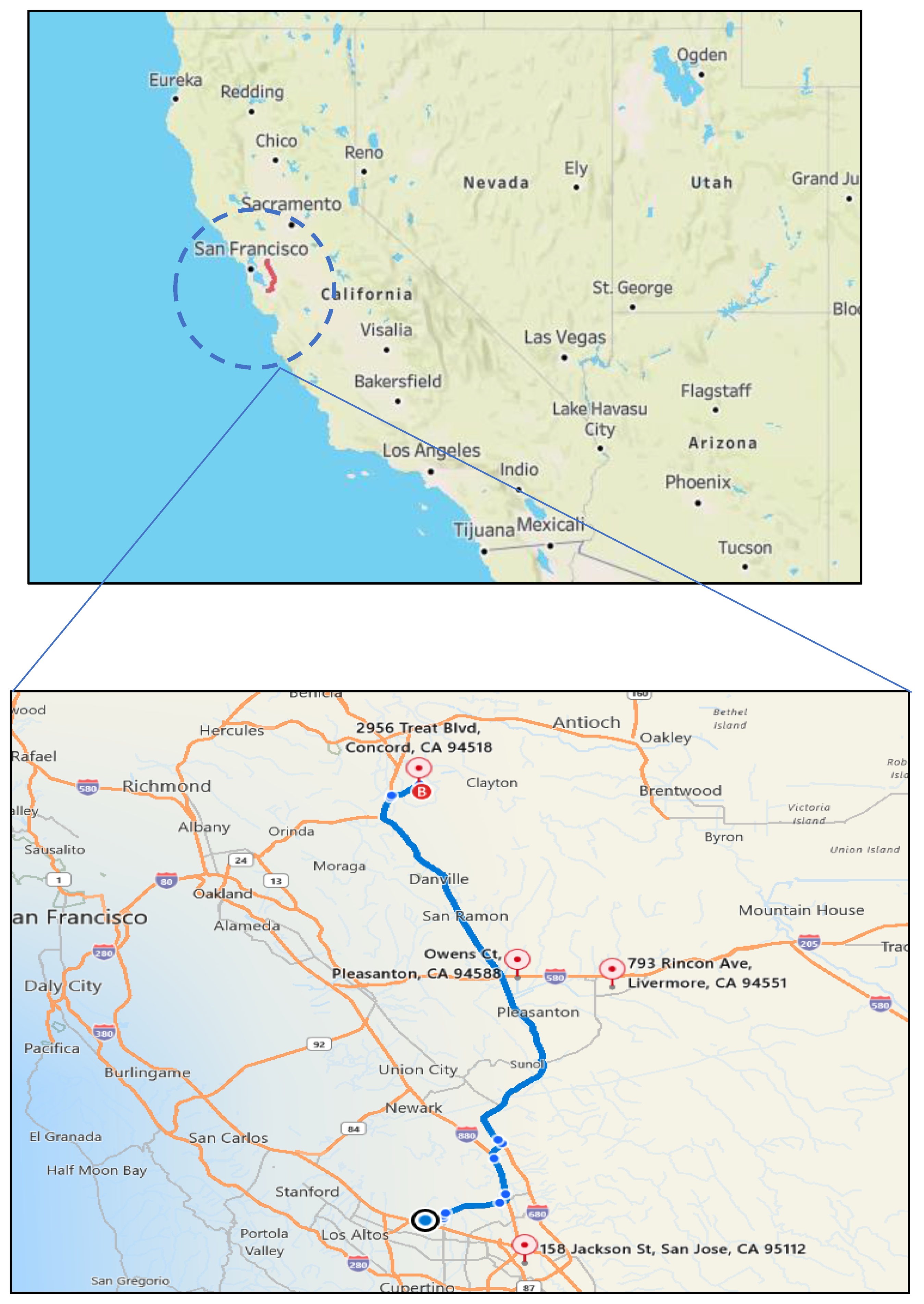
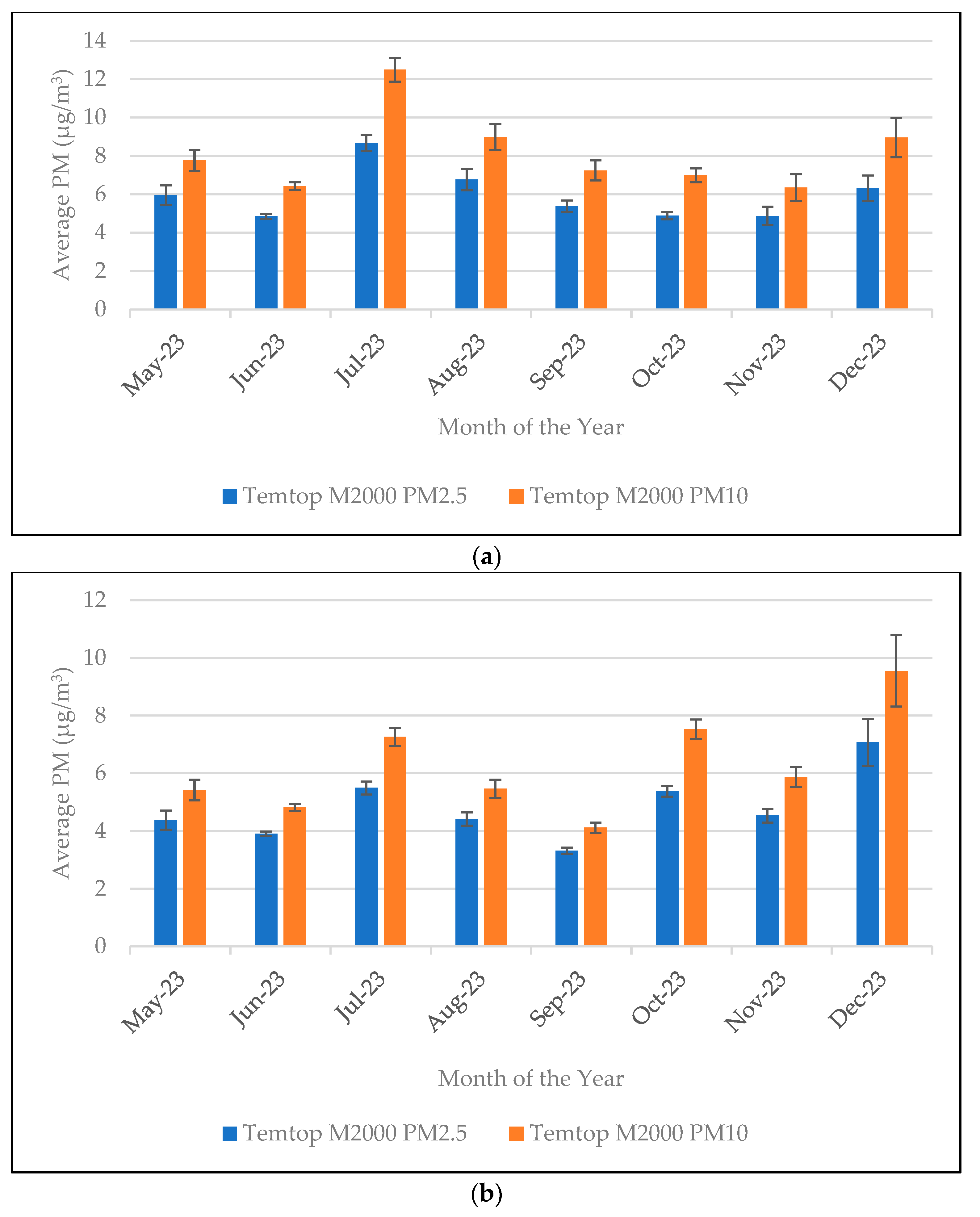

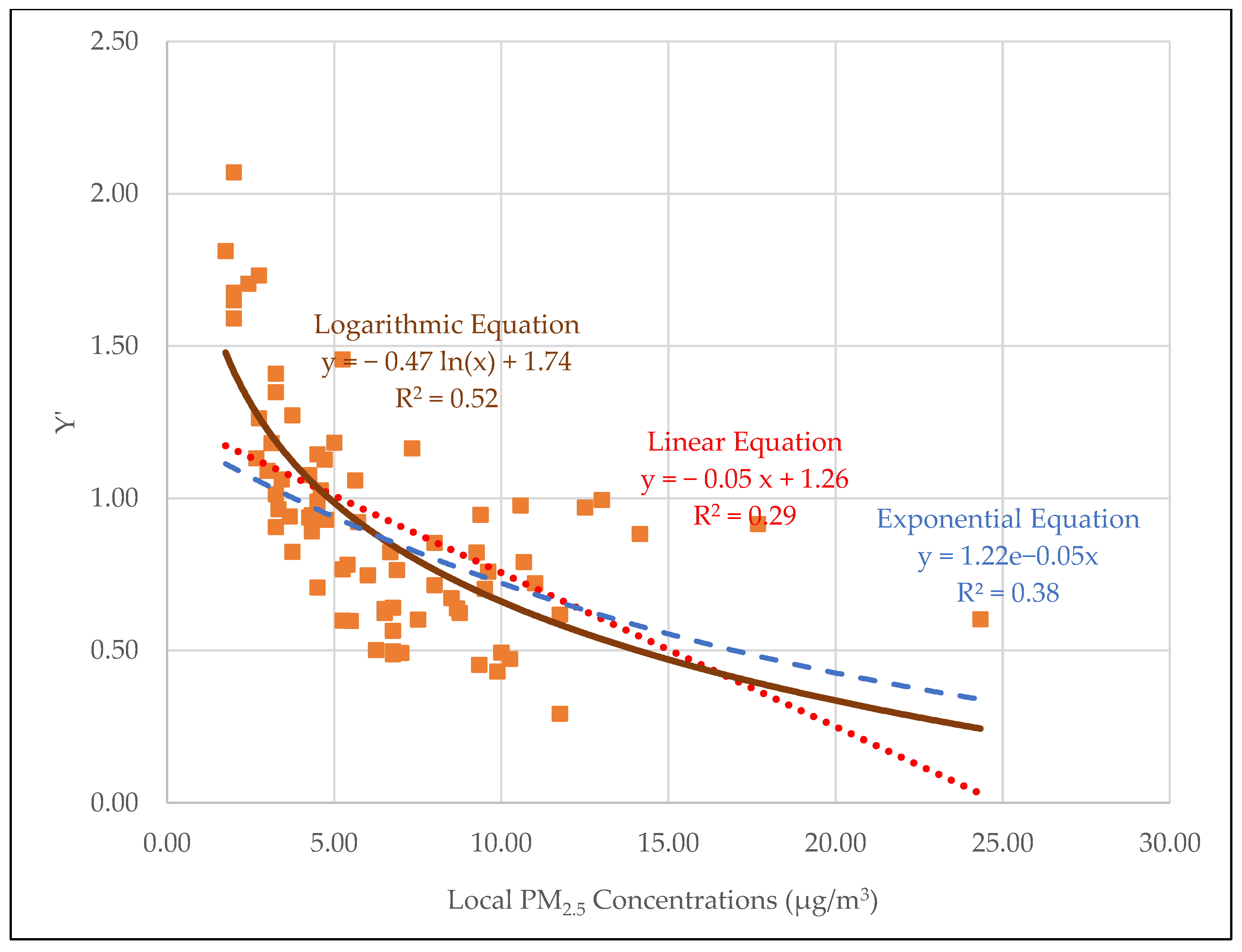
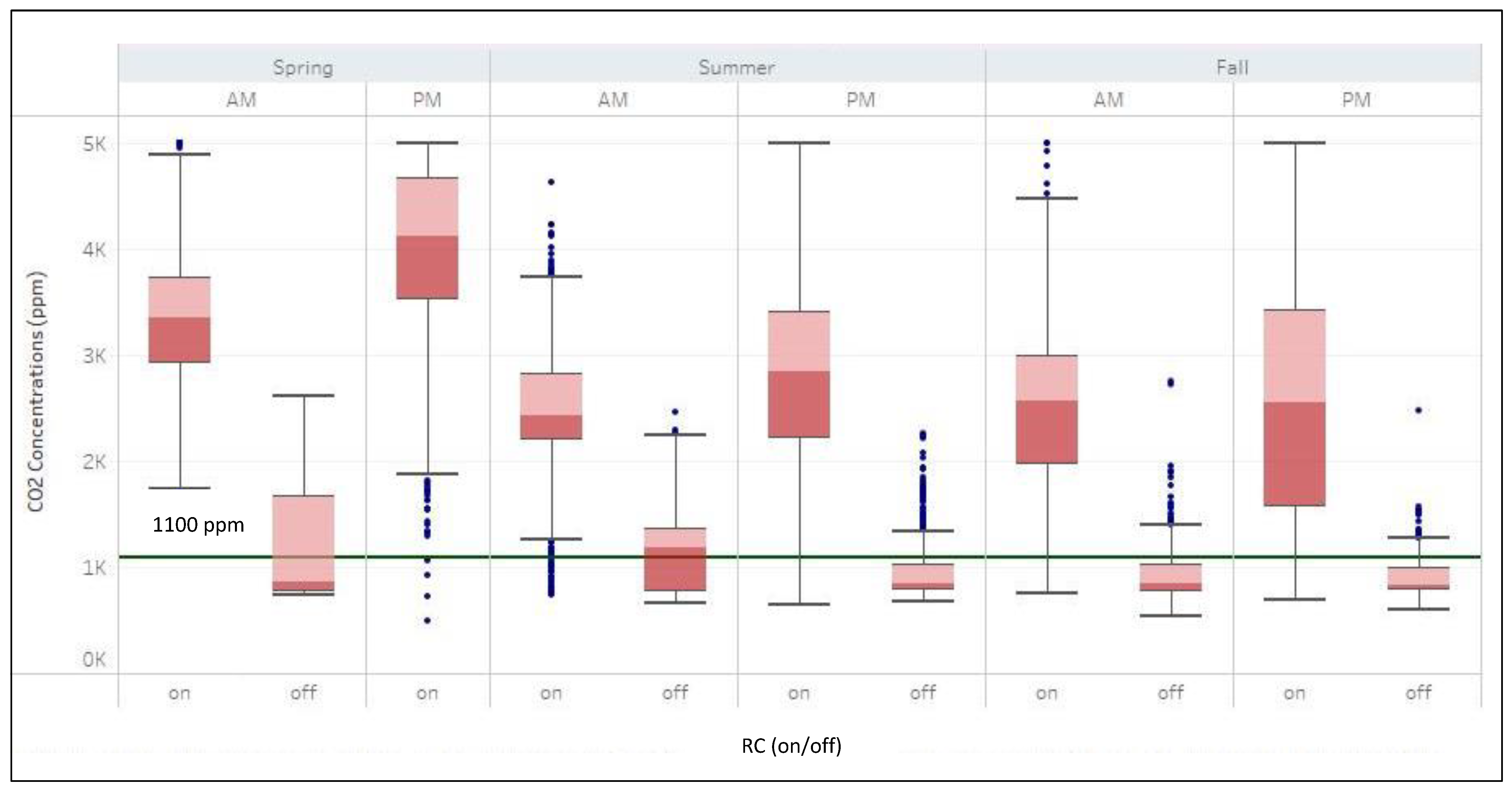
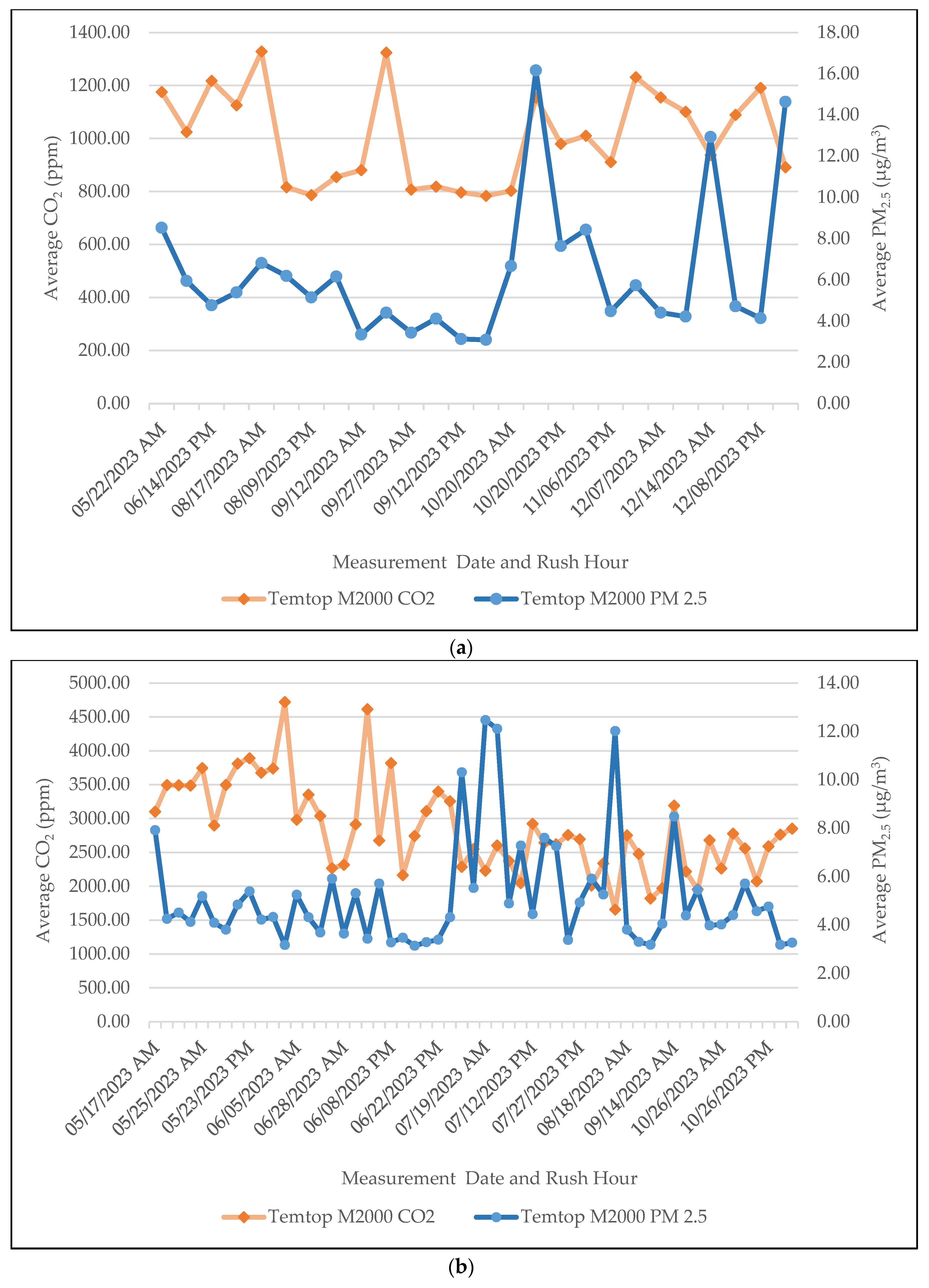
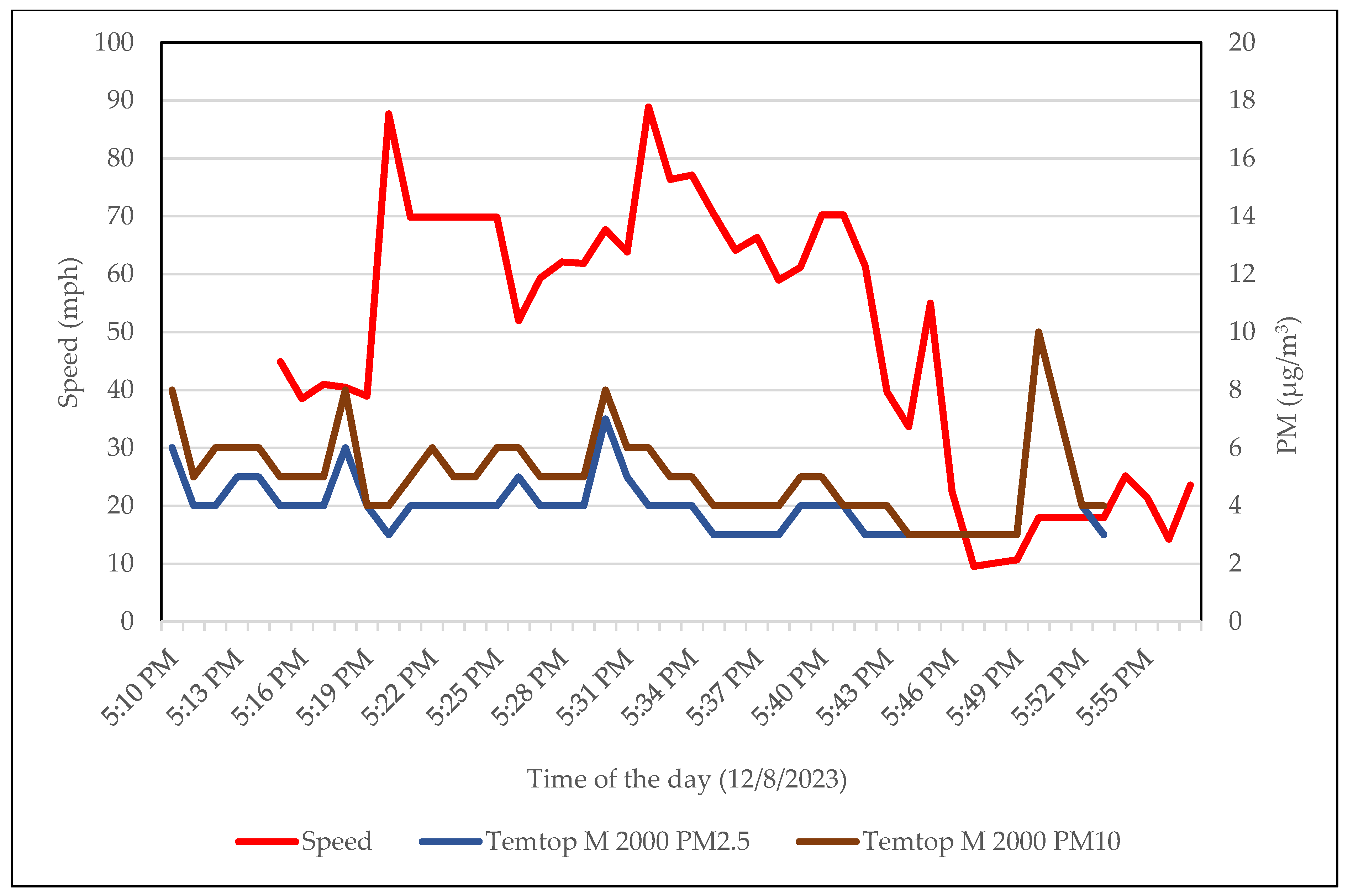
| Study Area | PM2.5 Concentrations | Devices Used | Year of Publication |
|---|---|---|---|
| Barcelona, Spain | On average, 30 µg/m3 during morning rush hour and 25 µg/m3 during evening rush hour | DustTrak (TSI, 8520) | 2012 [11] |
| Sacramento, CA, USA | 7.1 ± 3.3 µg/m3 | DustTrak (TSI 8520) | 2017 [8] |
| Taipei, Taiwan | Range: 8–80 µg/m3 Average: 15 µg/m3 | Temtop P600 Air Quality Laser Particle Detector | 2021 [12] |
| 10 cities in Asia, Africa, and South America | 16–65 µg/m3 on average | Dylos Laser Particle Counter | 2021 [9] |
| Birmingham, UK | 6.4 ± 2.7 µg/m3 | OPS Spectrometer, TSI Model 3330 | 2023 [10] |
| This Study | 5.07–6.55 µg/m3, and 4.38–4.47 µg/m3 during morning and evening rush hours, respectively. | Temtop M2000 and Flow 2 | 2024 |
| Type | Season | Temtop M2000 PM2.5 (µg/m3) (Mean ± SD) | Temtop M2000 PM10 (µg/m3) (Mean ± SD) | Average Relative Humidity (%) | Average Local PM2.5 (µg/m3) |
|---|---|---|---|---|---|
| In-vehicle | Spring | 5.96 ± 5.56 | 7.76 ± 6.13 | 79.63 | 7.53 |
| In-vehicle | Summer | 6.55 ± 3.75 | 8.99 ± 5.19 | 78.13 | 6.89 |
| In-vehicle | Fall | 5.07 ± 2.33 | 6.95 ± 3.85 | 81.08 | 6.46 |
| In-vehicle | Winter * | 6.31 ± 3.85 | 8.95 ± 5.90 | 95.50 | 7.72 |
| Type | Season | Temtop M2000 PM2.5 (µg/m3) (Mean ± SD) | Temtop M2000 PM10 (µg/m3) (Mean ± SD) | Average Relative Humidity (%) | Average Local PM2.5 (µg/m3) |
|---|---|---|---|---|---|
| In-vehicle | Spring | 4.38 ± 3.24 | 5.42 ± 3.57 | 57.17 | 7.47 |
| In-vehicle | Summer | 4.47 ± 1.89 | 5.65 ± 2.70 | 52.90 | 6.24 |
| In-vehicle | Fall | 4.46 ± 1.64 | 5.95 ± 2.80 | 57.23 | 4.95 |
| In-vehicle | Winter * | 7.07 ± 4.91 | 9.55 ± 7.49 | 80.00 | 10.31 |
| Sensor | Equation | R2 | RMSE | MAPE |
|---|---|---|---|---|
| Temtop M2000 | Logarithmic | 0.52 | 0.33 | 27.51% |
| Exponential | 0.38 | 0.35 | 29.72% | |
| Linear | 0.29 | 0.35 | 33.26% |
| Date and Trip | Average Speed (km/h) | Correlation R between PM2.5 and Speed | Correlation R between PM10 and Speed |
|---|---|---|---|
| 19 May 2023 a.m. | 90.93 | 0.076 | 0.076 |
| 25 May 2023 p.m. | 76.28 | 0.01 | 0.008 |
| 5 June 2023 p.m. | 77.38 | 0.15 | 0.28 |
| 22 June 2023 p.m. | 70.58 | 0.09 | 0.04 |
| 20 July 2023 a.m. | 96.56 | 0.15 | 0.10 |
| 10 August 2023 a.m. | 96.67 | 0.22 | 0.32 |
| 25 September 2023 a.m. | 104.60 | 0.16 | 0.20 |
| 10 October 2023 p.m. | 86.87 | −0.07 | −0.01 |
| 8 December 2023 p.m. | 78.86 | −0.12 | 0.14 |
| 14 December 2023 p.m. | 64.90 | 0.21 | 0.17 |
Disclaimer/Publisher’s Note: The statements, opinions and data contained in all publications are solely those of the individual author(s) and contributor(s) and not of MDPI and/or the editor(s). MDPI and/or the editor(s) disclaim responsibility for any injury to people or property resulting from any ideas, methods, instructions or products referred to in the content. |
© 2024 by the authors. Licensee MDPI, Basel, Switzerland. This article is an open access article distributed under the terms and conditions of the Creative Commons Attribution (CC BY) license (https://creativecommons.org/licenses/by/4.0/).
Share and Cite
Deevi, R.; Lu, M. In-Vehicle Air Pollutant Exposures from Daily Commute in the San Francisco Bay Area, California. Atmosphere 2024, 15, 1130. https://doi.org/10.3390/atmos15091130
Deevi R, Lu M. In-Vehicle Air Pollutant Exposures from Daily Commute in the San Francisco Bay Area, California. Atmosphere. 2024; 15(9):1130. https://doi.org/10.3390/atmos15091130
Chicago/Turabian StyleDeevi, Reshmasri, and Mingming Lu. 2024. "In-Vehicle Air Pollutant Exposures from Daily Commute in the San Francisco Bay Area, California" Atmosphere 15, no. 9: 1130. https://doi.org/10.3390/atmos15091130
APA StyleDeevi, R., & Lu, M. (2024). In-Vehicle Air Pollutant Exposures from Daily Commute in the San Francisco Bay Area, California. Atmosphere, 15(9), 1130. https://doi.org/10.3390/atmos15091130







